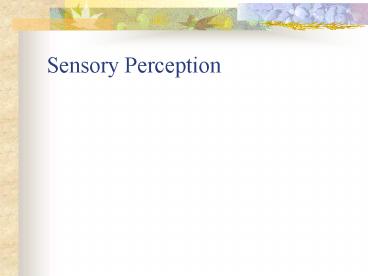Sensory Perception - PowerPoint PPT Presentation
1 / 38
Title:
Sensory Perception
Description:
Sensory Perception. I. Sensory Perception. A. Special senses. B. General senses. C. Sensation ... 2. External auditory meatus. B. Middle ear. 1. Tympanic membrane ... – PowerPoint PPT presentation
Number of Views:74
Avg rating:3.0/5.0
Title: Sensory Perception
1
Sensory Perception
2
I. Sensory Perception
A. Special senses
B. General senses
C. Sensation
1. Stimulus
2. Receptor
3. CNS
4. Translated
D. Adaptation
3
(No Transcript)
4
II. General Sensation - Receptors
A. Free Nerve endings
1. Pain
2. Itch
3. Movement
4. Temperature
B. Merkels disks
- light touch
C. Hair follicle receptors
- bending of hair light touch
5
D. Pacinian corpuscles
- deep pressure - vibration
E. Meissners corpuscles
- two-point discrimination
F. Ruffinis end organs
- touch or pressure
G. Golgi tendon ogans
- stimulated by tension on the tendon
6
(No Transcript)
7
III Olfaction
A. Olfactory epithelium
1. Bipolar neurons (olfactory
neuron)
- Olfactory vesicle (knob)
- axons -gt olfactory bulb
2. Odor reception
- olfactory binding proteins
- depolarize -gt AP
C. Signal transmission
- bipolar to mitral and tufted cells in Olfactory
bulb
8
(No Transcript)
9
(No Transcript)
10
- axons of tufted/mitral synapse in cortex
Lateral olfactory area conscious perception
Medial olfactory area
visceral emotional
Intermediate olfactory modify
olfactory signals
VI. Taste
A. Structures
1. Taste buds
- Fungiform papillae
- Foliate
- Vallate
2. Taste pore
11
(No Transcript)
12
(No Transcript)
13
3. Gustatory hairs
- receptor cells
B. Taste reception
1. Sour sides of tongue
- acids H enter channels
- bind (prevent K leaving)
- bind (open ion channel)
2. Salty tip of tongue
- low sensitivity
- Na diffuses
3. Bitter back of tongue
- high sensitivity
14
(No Transcript)
15
- G protein
4. Sweet tip of tongue
- low sensitivity
- G protein
C. Signal transmission
1. Afferent nerves
- Facial nerve anterior 2/3
- Glossopharyngeal nerve posterior 1/3
2. Medulla oblongata
- synapse w/ 2nd neurons
16
(No Transcript)
17
3. Thalamus
- synapse w/third neuron
4. Cortex
- terminates in postcentral gyrus
V. Hearing
A. External ear
1. Auricle
2. External auditory meatus
B. Middle ear
1. Tympanic membrane
2. Ossicles Malleus, Incus, Stapes
18
(No Transcript)
19
C. Inner Ear
1. Oval window
- connects middle and inner ear
2. Bony Labyrinth
a.) Cochlea
- Scala vestibuli
perilymph
- Scala tympani
b.) Vestibule
c.) Semicircular canals
20
(No Transcript)
21
3. Membranous Labyrinth
- vestibular membrane (beneath scala vestibuli)
- basilar membrane (above scala tympani)
- cochlear duct (endolymph)
Spiral organ -gt hair cells
D. Signal Transmission
- Sound waves cause vibrations
Tympanic membrane -gtossicles
-gtoval window -gt
- create waves in perilymph (scala vestibuli)
- deflect membranes
22
(No Transcript)
23
(No Transcript)
24
- microvilli on hair cell bends
- hair cell depolarizes
- action potential in cochlear nerve fibers
- synapse w/ cochlear nuclei in medulla
Superior Olivary Nucleus
Inferior colliculus
Medial geniculate nucleus of
thalamus
auditory cortex
25
(No Transcript)
26
VI. Visual Perception
A. Light
- Photon
- Wave
B. Perception
1. Cornea and lens
2. Retina
- Photoreceptors (Rods/Cones)
- fovea high cone concentration
- Optic disc blind spot
27
(No Transcript)
28
(No Transcript)
29
3. Photoreceptors
a) Rods
- low light
- achromatic
b) Cones
- reguires more light
- chromatic
C. Phototransduction
1. Photopigment
- Rhodopsin - rods
Retinal/Opsin
- Iodopsin - cones
30
(No Transcript)
31
2. Light
- retinal changes shape
- opsin protein changes
- activates G protein (transducin)
- activation of cGMP phosphodiesterase
- breaks down cGMP
- closes Na channels
- photoreceptor -gt hyperpolarizes
- reduction in Glutamate released
32
(No Transcript)
33
(No Transcript)
34
3. Dark vs.
Light
cGMP opens Na channels
Na channels closed no cGMP (G protein)
Photoreceptor depolarize
Photoreceptor hyperpolarize
Glutamate released
Decrease in Glutamate
Bipolar - hyperpolarizes
Bipolar - depolarizes
35
4. Bipolar cell
- synapses with photoreceptors
- depolarizes w/light
- synapses with ganglion cells
5. Ganglion cell
- synapses with bipolar cells
- axons extend into optic nerve
6. Horizontal cells
- connect multiple photoreceptors cells
7. Amacrine cells
- connect multiple ganglion cells
36
(No Transcript)
37
D. Neuronal pathway
- optic nerves from both eyes optic chiasma
- nasal retina inf cross over
- temporal retina inf same side
Lateral geniculate nucleus of
thalamus
Visual cortex
38
(No Transcript)































